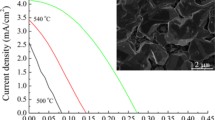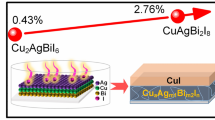Abstract
The use of transparent conducting oxide (TCO) as a substrate in Cu2ZnSn(S,Se)4 (CZTSSe) thin-film solar cells allows for advanced applications, such as bifacial, semi-transparent, and tandem solar cells with the capability to increase power density generation. However, the efficiency of this kind of solar cell is still below 6% based on the low-cost solution process. In this work, we develop a composition gradient strategy and demonstrate a 6.82% efficient CZTSSe solar cell on F:SnO2 (FTO) substrate under the ambient condition. The composition gradient is realized by simply depositing the precursor inks with different Zn/Sn ratios. To verify that the high performance of the solar cell is attributed to the composition gradient strategy rather than the sole change of the Zn/Sn ratio, devices based on absorbers with varied Zn/Sn ratios are fabricated. Furthermore, the structure and surface morphology of the CZTSSe films with/without composition gradients are examined. The presence of elemental gradient through the depth of the CZTSSe films before and after annealing is confirmed by secondary ion mass spectroscopy analysis. It is found that the composition gradient enhances the crystallinity of the absorber, reduces the surface roughness as well as device parasitic losses, contributing to a higher fill factor, open-circuit voltage and conversion efficiency.

摘要
使用透明导电氧化物玻璃作为铜锌锡硫硒(CZTSSe)薄膜太阳电池的衬底可拓展其应用范围, 如双面电池、半透明电池或者叠层电池.目前, 基于溶液法制备的该类太阳电池的光电转换效率仍低于6%. 本文中, 我们开发了一种成分梯度策略, 并在空气环境中于掺氟二氧化锡衬底上制备出了光电转换效率为6.82%的CZTSSe薄膜太阳电池. 成分梯度主要是通过沉积具有不同Zn/Sn比的分子前驱体溶液来实现的. 为了证明电池性能的提高归因于成分梯度, 而非单纯改变Zn/Sn比, 本工作制备并比较了基于不同Zn/Sn比吸收层的器件性能. 此外, 本工作对有/无成分梯度的CZTSSe薄膜的结构和表面形貌进行了研究, 并通过二次离子质谱分析证实了退火前后CZTSSe薄膜成分的深度梯度分布. 研究发现, 成分梯度策略改善了吸收层的结晶性, 降低了吸收层的表面粗糙度及器件的寄生损耗, 从而提高了填充因子、开路电压和转换效率.
Similar content being viewed by others
References
Katagiri H, Jimbo K, Maw WS, et al. Development of CZTS-based thin film solar cells. Thin Solid Films, 2009, 517: 2455–2460
Mitzi DB, Gunawan O, Todorov TK, et al. The path towards a high-performance solution-processed kesterite solar cell. Sol Energy Mater Sol Cells, 2011, 95: 1421–1436
Ki W, Hillhouse HW. Earth-abundant element photovoltaics directly from soluble precursors with high yield using a non-toxic solvent. Adv Energy Mater, 2011, 1: 732–735
Ramasamy K, Malik MA, O’Brien P. Routes to copper zinc tin sulfide Cu2ZnSnS4 a potential material for solar cells. Chem Commun, 2012, 48: 5703–5714
Wang D, Zhao W, Zhang Y, et al. Path towards high-efficient kesterite solar cells. J Energy Chem, 2018, 27: 1040–1053
Shockley W, Queisser HJ. Detailed balance limit of efficiency of p-n junction solar cells. J Appl Phys, 1961, 32: 510–519
Wang W, Winkler MT, Gunawan O, et al. Device characteristics of CZTSSe thin-film solar cells with 12.6% efficiency. Adv Energy Mater, 2014, 4: 1301465
Crovetto A, Hansen O. What is the band alignment of Cu2ZnSn(S,Se)4 solar cells? Sol Energy Mater Sol Cells, 2017, 169: 177–194
Sardashti K, Chagarov E, Antunez PD, et al. Nanoscale characterization of back surfaces and interfaces in thin-film kesterite solar cells. ACS Appl Mater Interfaces, 2017, 9: 17024–17033
Wang D, Wu J, Guo H, et al. Tuning the work function of the metal back contact toward efficient Cu2ZnSnSe4 solar cells. Sol RRL, 2021, 5: 2000391
Zhao Y, Han X, Chang L, et al. Effects of selenization conditions on microstructure evolution in solution processed Cu2ZnSn(S,Se)4 solar cells. Sol Energy Mater Sol Cells, 2019, 195: 274–279
Liu X, Guo J, Hao R, et al. Cliff-like conduction band offset at CdS/Cu2ZnSnS4 heterojunction prepared by sputtering CuSn alloy target using different stacking order. Sol Energy, 2019, 183: 285–292
Shin SW, Pawar SM, Park CY, et al. Studies on Cu2ZnSnS4 (CZTS) absorber layer using different stacking orders in precursor thin films. Sol Energy Mater Sol Cells, 2011, 95: 3202–3206
Olgar MA, Klaer J, Mainz R, et al. Effect of precursor stacking order and sulfurization temperature on compositional homogeneity of CZTS thin films. Thin Solid Films, 2016, 615: 402–408
Khan SN, Ge SJ, Gu EN, et al. Bifacial Cu2ZnSn(S,Se)4 thin film solar cell based on molecular ink and rapid thermal processing. Adv Mater Interfaces, 2021, doi: https://doi.org/10.1002/admi.202100971.
Ge S, Xu H, Huang Y, et al. Surprising efficiency enhancement of Cu2ZnSn(S,Se)4 solar cells with abnormal Zn/Sn ratios. Sol RRL, 2020, 4: 2000325
Li S, Lloyd MA, McCandless BE, et al. Effects of cation composition on carrier dynamics and photovoltaic performance in Cu2ZnSnSe4 monocrystal solar cells. Sol Energy Mater Sol Cells, 2020, 205: 110255
Chen S, Wang LW, Walsh A, et al. Abundance of CuZn + SnZn and 2CuZn + SnZn defect clusters in kesterite solar cells. Appl Phys Lett, 2012, 101: 223901
Duan B, Shi J, Li D, et al. Underlying mechanism of the efficiency loss in CZTSSe solar cells: Disorder and deep defects. Sci China Mater, 2020, 63: 2371–2396
Sun Y, Qiu P, Wang S, et al. Defect control for high-efficiency Cu2ZnSn(S,Se)4 solar cells by atomic layer deposition of Al2O3 on precursor film. Sol RRL, 2021, 5: 2100181
Zhang S, Hadi HD, Wang Y, et al. A precursor stacking strategy to boost open-circuit voltage of Cu2ZnSnS4 thin-film solar cells. IEEE J Photovoltaics, 2018, 8: 856–863
Weber A, Mainz R, Schock HW. On the Sn loss from thin films of the material system Cu-Zn-Sn-S in high vacuum. J Appl Phys, 2010, 107: 013516
Scragg JJ, Ericson T, Kubart T, et al. Chemical insights into the instability of Cu2ZnSnS4 films during annealing. Chem Mater, 2011, 23: 4625–4633
Yan C, Huang J, Sun K, et al. Cu2ZnSnS4 solar cells with over 10% power conversion efficiency enabled by heterojunction heat treatment. Nat Energy, 2018, 3: 764–772
Wang S, Shen Z, Wu J, et al. Nanoscale surface electrical properties tailored by room-temperature sulfurization for high-efficient CZTSe solar cells. Adv Mater Interfaces, 2020, 7: 2000564
Wang S, Shen Z, Sun Y, et al. Defects and surface electrical property transformation induced by elemental interdiffusion at the p-n heterojunction via high-temperature annealing. ACS Appl Mater Interfaces, 2021, 13: 12211–12220
Sarswat PK, Free ML. Demonstration of a sol-gel synthesized bifacial CZTS photoelectrochemical cell. Phys Status Solidi A, 2011, 208: 2861–2864
Ge J, Chu J, Jiang J, et al. Characteristics of in-substituted CZTS thin film and bifacial solar cell. ACS Appl Mater Interfaces, 2014, 6: 21118–21130
Ge J, Chu J, Jiang J, et al. The interfacial reaction at ITO back contact in kesterite CZTSSe bifacial solar cells. ACS Sustain Chem Eng, 2015, 3: 3043–3052
Ge J, Chu J, Yan Y, et al. Co-electroplated kesterite bifacial thin-film solar cells: A study of sulfurization temperature. ACS Appl Mater Interfaces, 2015, 7: 10414–10428
Ge J, Yu Y, Ke W, et al. Improved performance of electroplated CZTS thin-film solar cells with bifacial configuration. ChemSusChem, 2016, 9: 2149–2158
Kim JS, Kang JK, Hwang DK. High efficiency bifacial Cu2ZnSnSe4 thin-film solar cells on transparent conducting oxide glass substrates. APL Mater, 2016, 4: 096101
Espindola-Rodriguez M, Sylla D, Sánchez Y, et al. Bifacial kesterite solar cells on FTO substrates. ACS Sustain Chem Eng, 2017, 5: 11516–11524
Wang Z, Tao J, Xiao W, et al. Influence of deposition potential on Cu2ZnSnS4 thin-film solar cells co-electrodeposited on fluorine-doped tin oxide substrates. J Alloys Compd, 2017, 701: 465–473
Franckevičius M, Pakštas V, Grincienė G, et al. Efficiency improvement of superstrate CZTSSe solar cells processed by spray pyrolysis approach. Sol Energy, 2019, 185: 283–289
Kim JS, Kim DH, Hwang DK. Efficiency enhancement of bifacial Cu2ZnSnSe4 thin-film solar cells on indium tin oxide glass substrates by suppressing In-Sn diffusion with Mo interlayer. J Power Sources, 2018, 400: 9–15
Becerril-Romero I, Sylla D, Placidi M, et al. Transition-metal oxides for kesterite solar cells developed on transparent substrates. ACS Appl Mater Interfaces, 2020, 12: 33656–33669
Ge S, Gao H, Hong R, et al. Improvement of Cu2ZnSn(S,Se)4 solar cells by adding N,N-dimethylformamide to the dimethyl sulfoxide-based precursor ink. ChemSusChem, 2019, 12: 1692–1699
Patterson AL. The scherrer formula for X-ray particle size determination. Phys Rev, 1939, 56: 978–982
Williamson GK, Smallman RE. III. Dislocation densities in some annealed and cold-worked metals from measurements on the X-ray Debye-Scherrer spectrum. Philos Mag, 1956, 1: 34–46
Riha SC, Parkinson BA, Prieto AL. Solution-based synthesis and characterization of Cu2ZnSnS4 nanocrystals. J Am Chem Soc, 2009, 131: 12054–12055
Fernandes PA, Salomé PMP, Cunha AF. A study of ternary Cu2SnS3 and Cu3SnS4 thin films prepared by sulfurizing stacked metal precursors. J Phys D-Appl Phys, 2010, 43: 215403
Fernandes PA, Salomé PMP, da Cunha AF. Study of polycrystalline Cu2ZnSnS4 films by raman scattering. J Alloys Compd, 2011, 509: 7600–7606
Salomé PMP, Fernandes PA, da Cunha AF. Morphological and structural characterization of Cu2ZnSnSe4 thin films grown by selenization of elemental precursor layers. Thin Solid Films, 2009, 517: 2531–2534
Fernandes PA, Salomé PMP, da Cunha AF. Growth and Raman scattering characterization of Cu2ZnSnS4 thin films. Thin Solid Films, 2009, 517: 2519–2523
Grossberg M, Krustok J, Raudoja J, et al. Photoluminescence and Raman study of Cu2ZnSn(SexS1−x)4 monograins for photovoltaic applications. Thin Solid Films, 2011, 519: 7403–7406
Dimitrievska M, Fairbrother A, Saucedo E, et al. Influence of compositionally induced defects on the vibrational properties of device grade Cu2ZnSnSe4 absorbers for kesterite based solar cells. Appl Phys Lett, 2015, 106: 073903
Wang S, Jiang Z, Shen Z, et al. Promising Cd-free double buffer layer in CZTSSe thin film solar cells. Sci China Mater, 2021, 64: 288–295
Hegedus SS, Shafarman WN. Thin-film solar cells: Device measurements and analysis. Prog Photovolt-Res Appl, 2004, 12: 155–176
Swartz GA. Computer model of amorphous silicon solar cell. J Appl Phys, 1982, 53: 712–719
Sites JR, Mauk PH. Diode quality factor determination for thin-film solar cells. Sol Cells, 1989, 27: 411–417
Acknowledgements
This work was supported by the National Natural Science Foundation of China (62074168), and the Fundamental Research Foundations for the Central Universities (20lgpy04). We also thank Prof. Hui Shen, Prof. Wan Yue, Prof. Zhengke Li and Prof. Zhuang Xie for the facility support.
Author information
Authors and Affiliations
Contributions
Lin X conceived and supervised the project; Khan SN conducted most of the experiments and wrote the draft of the manuscript; Ge S and Huang Y prepared some of the samples. Xu H supported the annealing of samples. Yang W performed X-ray diffraction measurements; Hong R, Mai Y and Yang G participated in the discussion and analysis of the data. Khan SN, Gu E and Lin X wrote the manuscript with discussion and input from all the authors.
Corresponding authors
Additional information
Conflict of interest
The authors declare that they have no conflict of interest.
Saqib Nawaz Khan received his Master’s degree in materials physics and chemistry from Sun Yat-Sen University in 2021. Currently he is pursuing his doctoral degree at the Institute of Physics, Chinese Academy of Sciences. His research interest includes the synthesis and characterization of energy materials and their applications in optoelectronic devices. His current research focus is on kesterite Cu2ZnSn(S,Se)4 and perovskite thin-film solar cells.
Ening Gu received her PhD degree in materials science from Friedrich-Alexander-Universität Erlangen-Nürnberg in 2019 under the supervison of Prof. Christoph J. Brabec. Currently, she works as a postdoctoral fellow at the School of Materials Science and Engineering, Sun Yat-Sen University. Her research interests focus on emerging photovoltaic materials, solution-processed optoelectronic semiconductors and devices.
Xianzhong Lin received his PhD degree from Technische Universität Berlin, Germany, in 2014. Before joining Sun Yat-Sen University as an associate professor in 2017, he worked as a postdoctoral researcher at Helmholtz-Zentrum Berlin für Materialien und Energie and Friedrich-Alexander-Universität Erlangen-Nürnberg for three years. His research focuses on highly efficient and stable thin-film solar cells based on printing approach.
Rights and permissions
About this article
Cite this article
Khan, S.N., Ge, S., Huang, Y. et al. Highly efficient Cu2ZnSn(S,Se)4 bifacial solar cell via a composition gradient strategy through the molecular ink. Sci. China Mater. 65, 612–619 (2022). https://doi.org/10.1007/s40843-021-1769-7
Received:
Accepted:
Published:
Issue Date:
DOI: https://doi.org/10.1007/s40843-021-1769-7




